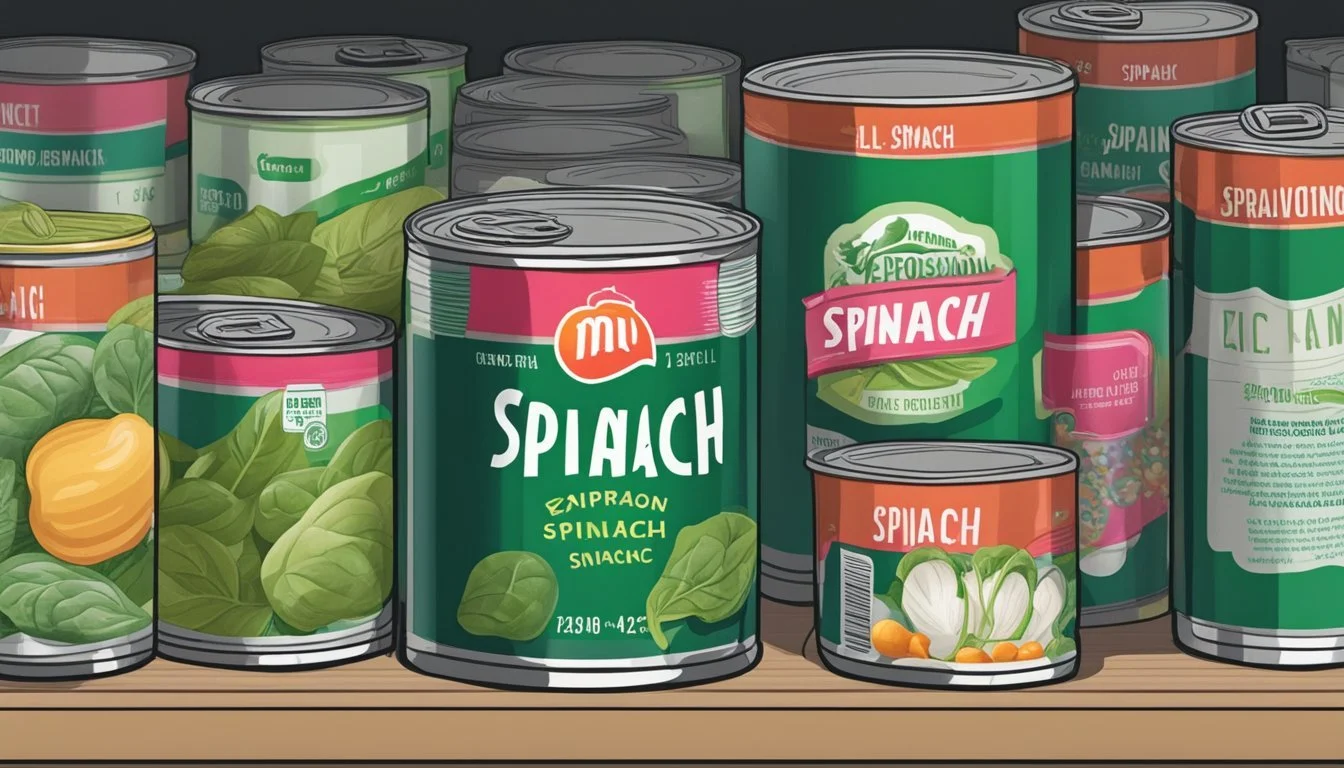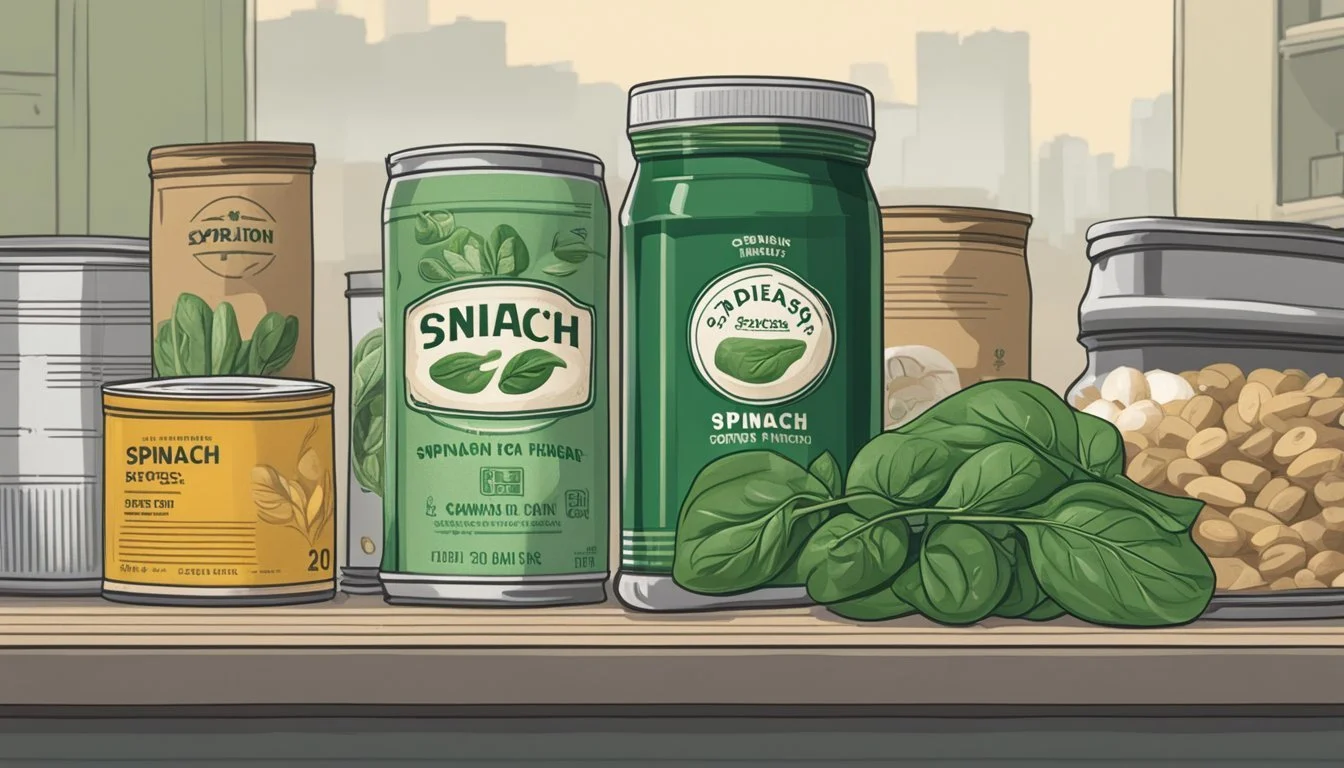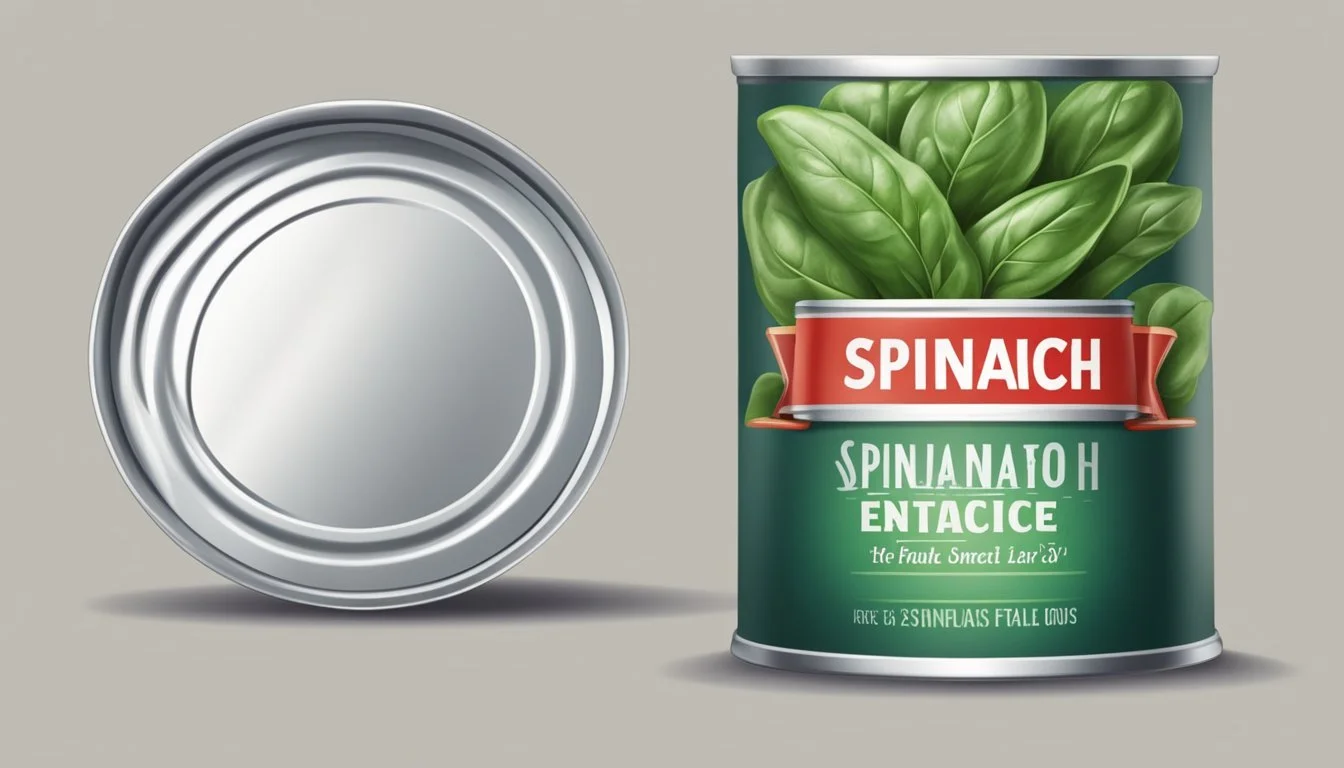Does Canned Spinach Expire?
Shelf Life and Storage Tips
Canned spinach is a convenient and nutritious addition to many meals, but like all food items, it has a shelf life that should be considered. Unopened canned spinach generally stays at its best quality for about 3 to 5 years when stored properly in a cool, dry area. Although it remains safe to consume beyond this period, its taste and texture might decline over time.
Once a can of spinach is opened, it should be transferred to a refrigerator where it can last for up to 5-7 days. It's important to ensure that the container remains tightly sealed to preserve its freshness and nutritional value. Consuming expired canned spinach poses a risk of food poisoning, especially if the can is damaged or improperly stored.
While canned spinach provides an excellent source of essential nutrients such as iron and vitamins, paying attention to expiration dates and storage conditions is crucial for safety. Despite its impressive shelf life, proper management of canned goods guarantees a healthier and more enjoyable eating experience.
Understanding Food Expiration Dates
Expiration dates on canned foods, including spinach, indicate quality rather than safety. This section explores the meanings of these dates and the guidelines provided by the USDA.
Decoding Date Labels
Food products often come with a variety of date labels such as best-by, use-by, and sell-by. These dates help consumers manage the freshness and quality of their food items.
Best-by date: Indicates the period during which the product will be at its best quality.
Expiration date: Rarely used on canned foods. Instead, most foods feature a best-by date.
Sell-by date: Used mostly in retail, indicating how long the store should display the product.
The shelf life of canned spinach can vary but, in most cases, it remains safe to consume past the labeled date if stored correctly and the can is undamaged.
Canned Foods and USDA Guidelines
The U.S. Department of Agriculture (USDA) provides guidelines to ensure food safety and quality. According to the USDA, most canned foods, including spinach, can be safely consumed even after the expiration date if the can remains intact and the food shows no signs of spoilage.
Proper storage conditions, such as keeping cans in a cool, dry place, can significantly extend the shelf life.
The USDA points out that changes in texture or appearance do not necessarily indicate spoilage. However, if there's a foul odor, bulging, or leakage, the product should be discarded immediately for safety reasons.
Shelf Life of Canned Spinach
Canned spinach remains shelf-stable for extended periods if stored correctly. It is vital to differentiate between unopened and opened canned spinach to understand its shelf life.
Unopened Cans
Unopened canned spinach can maintain its peak quality for around 3 to 5 years when stored in a cool, dry place. The shelf life can be affected by factors like temperature and humidity. Proper storage conditions help preserve the texture and taste of the spinach.
Manufacturers often mark "best by" dates on cans, which serve as guidelines for peak quality rather than safety. Even past these dates, canned spinach can still be safe to consume if the can remains undamaged and properly sealed.
After Opening
Once the can is opened, the shelf life of spinach reduces significantly. Refrigeration is essential at this stage. Opened canned spinach should be transferred to a covered glass or plastic container and stored in the refrigerator.
Under continuous refrigeration, it generally lasts 3 to 7 days. The texture and taste may change during this period, but the spinach remains safe to eat as long as there are no signs of spoilage, such as an off smell or appearance.
Identifying Spoilage Signs
Canned spinach, like all canned foods, can spoil if conditions permit. Identifying spoilage signs involves visual inspection and assessing smell and texture to ensure food safety.
Visual Inspection
When inspecting canned spinach, look for any bulging or swelling of the can, which can indicate bacterial contamination. Leaking or rust on the can's exterior may also be signs of spoilage. Once opened, check if there is mold growing inside the can or on the spinach itself.
Discoloration: Healthy spinach should retain its green color. If the leaves appear darkened or have turned a different color, it is a sign that the spinach may no longer be safe to consume. Wilting or shriveling are additional indicators that the spinach might not be fresh.
Smell and Texture
Inspecting the smell is crucial. Fresh canned spinach should have a neutral or slightly vegetal odor. Off odors such as a sour, rancid, or metallic smell suggest spoilage and potential toxins caused by bacterial growth.
When it comes to texture, fresh spinach should be firm and leafy. Sliminess or an unusual texture is a clear warning sign of potential spoilage. Finally, if the spinach has a foul odor or feels slippery, it's a health risk, and consuming it could lead to food poisoning caused by contaminants like botulism.
Storage Best Practices
Proper storage is essential to ensure that canned spinach retains its quality and nutritional values as long as possible. To achieve this, several factors, such as maintaining a cool, dry environment and using appropriate containers after opening, should be considered.
Unopened Cans
For unopened canned spinach, storage conditions are crucial. It’s recommended to store these cans in a cool, dry place, such as a pantry or cupboard. Avoid areas exposed to direct sunlight or sources of heat, like the kitchen stove or garage.
An ideal storage temperature for canned spinach is around room temperature, typically between 50-70°F (10-21°C). Storing the cans in such conditions helps maintain the spinach's quality for about 3 to 5 years. While the spinach may be safe to eat indefinitely, its organoleptic qualities like taste and texture may degrade over time.
Opened Cans
Once a can of spinach is opened, its storage becomes more critical. Transfer the remaining spinach to an airtight container to prevent exposure to air, which can lead to spoilage. Then refrigerate the container immediately.
For longer storage, consider freezing the spinach. Place the spinach in airtight containers or heavy-duty freezer bags. When properly stored, the spinach can maintain its quality in the freezer for about two months. This method helps preserve the spinach's taste and texture better than refrigeration alone.
Both refrigerated and frozen spinach should be checked periodically for changes in smell, color, or texture to ensure they are still safe to consume. Proper storage practices significantly extend the usability of canned spinach after opening.
Canned Spinach Nutrition
Canned spinach offers a convenient and nutritious option for including vegetables in one's diet. It preserves many of the vitamins and minerals found in fresh spinach, but some nutrient loss does occur during the canning process.
Nutritional Content
Canned spinach retains many key nutrients. A standard serving provides essential vitamins such as Vitamin A, Vitamin C, and Vitamin K. It is also a good source of calcium, important for bone health, and iron, crucial for oxygen transport in the blood.
Nutritional values per 100 grams:
Calories: 23 kcal
Protein: 2.4 grams
Calcium: 130 mg
Iron: 2.6 mg
Despite these benefits, the canning process can reduce the levels of certain water-soluble vitamins, such as Vitamin C. However, canned spinach remains a healthy option when fresh spinach is unavailable.
Comparison With Fresh and Frozen Spinach
Fresh spinach is often considered the gold standard for nutrition. It typically contains higher levels of vitamins and minerals compared to canned spinach. However, fresh spinach's nutritional quality can degrade quickly if not consumed shortly after purchase.
Frozen spinach is a middle ground. It retains a high level of nutrients because it is flash-frozen shortly after harvesting. Canned spinach, on the other hand, can have reduced Vitamin C and folate levels but remains shelf-stable for years, making it a practical choice.
While canned spinach might not match the nutritional profile of fresh or frozen spinach entirely, it still offers substantial nutritional benefits and is significantly more convenient for long-term storage.
Extending Shelf Life through Freezing
Freezing canned spinach can significantly extend its shelf life. This method preserves nutritional value while maintaining food safety when done correctly.
Preparation for Freezing
Before freezing canned spinach, transfer it to airtight containers or heavy-duty freezer bags. Avoid freezing it directly in the can, as this can negatively affect the texture. Blanching, a method recommended by many food safety experts, is crucial. Blanch the spinach in boiling water for a few seconds, then cool it rapidly in an ice bath.
Ensure the spinach is well-drained before packing. Vacuum sealing can be beneficial, as it removes air and helps prevent freezer burn. Label the containers or bags with the date to keep track of storage time.
Thawing and Usage Tips
When ready to use, thaw frozen spinach by placing it in the refrigerator overnight. This gradual defrosting process helps maintain better texture and flavor. For quicker thawing, place the sealed bag in cold water. Avoid microwaving directly from frozen, as it can make the spinach mushy.
Incorporate thawed spinach into cooked dishes such as soups, stews, and casseroles. Freezing might slightly alter the texture, so it is less ideal for salads. Using proper freezing and thawing methods, spinach can stay safe to eat for up to 8-12 months.
Home Canning vs. Commercial Canning
Comparing home-canned and commercially canned spinach highlights key differences in safety considerations and shelf life. Here’s a breakdown of what you should be aware of:
Safety Considerations
Home-Canned Spinach:
Home canning allows for customization but requires stringent safety measures to avoid contamination. Proper sterilization of glass jars and lids is essential. High-acid foods are safer over time, while low-acid foods like spinach require a pressure canner to destroy Clostridium botulinum spores that can cause botulism. Always inspect home-canned goods for signs of spoilage like off-smell, discoloration, or bulging lids.
Commercially Canned Spinach:
Commercial canning utilizes high heat and controlled environments to ensure uniform safety and quality. Foods are packed in metal or glass containers that are sealed and sterilized effectively. The canning process for low-acid foods also employs pressure canning to kill harmful bacteria. Commercial canned goods often include preservatives to extend shelf life and ensure consistent flavor.
Recognizing Compromised Packaging
Inspecting the packaging of canned spinach is crucial to ensure its safety. Key indicators of compromised packaging include dents, swelling, rust, and leakage.
Dents and Swelling
Canned spinach should be free from dents and swelling. Dented cans can weaken the structural integrity, potentially leading to small cracks or openings. This can create a pathway for bacteria to enter, posing a health risk.
Swelling or bulging cans are a serious concern. This usually indicates bacterial growth inside the can, leading to the production of gas. Consuming contents from swollen or bulging cans can result in severe foodborne illnesses. Always discard any cans that show signs of swelling or bulging.
Rust and Leakage
Rust on canned spinach may compromise its protective coating. If rust penetrates the can, it can create small holes or cracks, making the spinach inside unsafe to eat.
Leakage is another significant warning sign. Cans with any signs of leakage indicate a breach in packaging, which not only reduces the can's shelf life but also introduces potential toxins. It’s vital to avoid using cans with any form of leakage to prevent possible health risks.
By being vigilant and recognizing these signs, one can ensure the canned spinach remains in good condition and safe for consumption.
Safe Consumption Guidelines
Canned spinach can be safe to eat past its expiration date if handled correctly. Key practices include proper reheating and cooking techniques, and knowing when to discard unsafe products to ensure food safety.
Reheating and Cooking
Canned spinach should be heated thoroughly before consumption to eliminate any potential health risks. It is recommended to reheat the spinach to at least 165°F (74°C). Using a microwave or stovetop ensures an even temperature throughout.
Leftovers should be stored in the refrigerator at a temperature below 40°F (4°C) and consumed within a few days. Always use a clean container to prevent contamination.
Avoid reheating spinach more than once, as repeated reheating can degrade the quality and safety of the food. Aim for a single, thorough heating session each time.
Discarding Unsafe Products
Check the integrity of the can before use. Avoid cans with bulges, dents, or rust, as these can indicate leaks or contamination. Bulging cans can be a sign of clostridium botulinum contamination, which produces harmful toxins.
Upon opening, inspect the spinach for off-putting smells, unusual colors, or a slimy texture. These are signs that the food is no longer safe to eat and should be discarded immediately.
Even if the can appears intact, it’s important to trust your senses. If anything seems off, it is better to err on the side of caution to avoid health risks. Always prioritize food safety.







